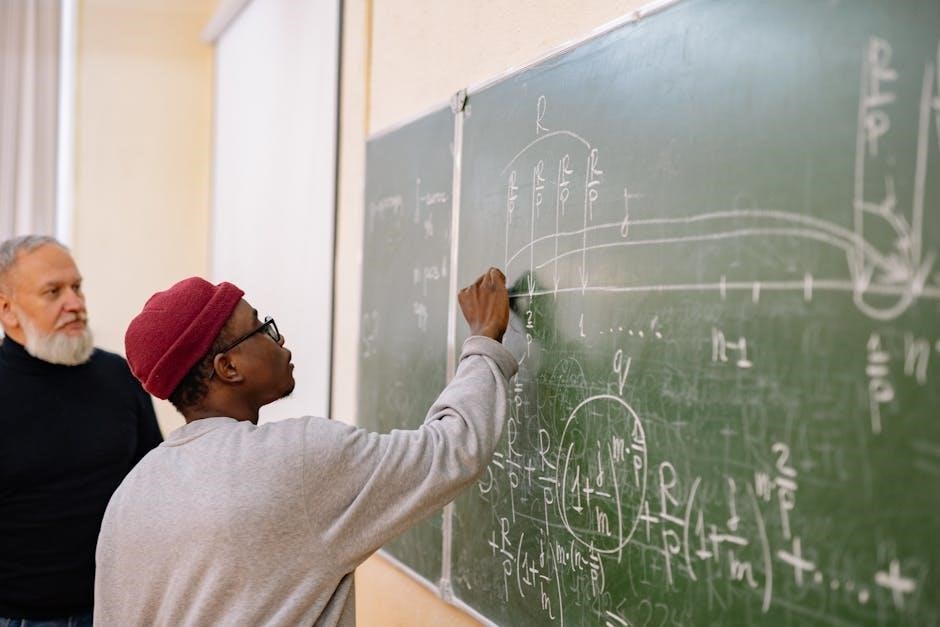gas laws questions and answers pdf
Gas Laws Questions and Answers PDF: A Comprehensive Guide
This comprehensive guide dives into the realm of gas laws, offering a collection of questions and answers in PDF format. It’s designed to help students and enthusiasts grasp the principles governing gases. Expect detailed explanations, problem-solving techniques, and real-world applications.

Overview of Gas Laws
Gas laws are a set of physical laws that describe the relationships between the macroscopic properties of gases, such as volume, pressure, temperature, and the amount of gas. These laws are fundamental to understanding the behavior of gases and are widely applied in various scientific and engineering fields. This section provides a comprehensive overview of these essential principles.
The primary gas laws include Boyle’s Law, which relates pressure and volume; Charles’s Law, which connects volume and temperature; and Gay-Lussac’s Law, which links pressure and temperature. The combined gas law integrates these three laws into a single equation. The ideal gas law, represented as PV=nRT, introduces the concept of the ideal gas constant and the number of moles of gas, offering a more comprehensive model for gas behavior.
Beyond these core laws, Dalton’s Law of Partial Pressures explains how to calculate the total pressure of a gas mixture, while Graham’s Law of Effusion describes the rate at which gases escape through a small opening. Understanding these laws is crucial for solving a wide range of problems related to gas behavior, from calculating gas densities to predicting how gases will react under different conditions. This section will lay the groundwork for a deeper dive into each of these laws in subsequent sections.
Boyle’s Law: Pressure and Volume Relationship
Boyle’s Law, formulated by Robert Boyle in 1662, describes the inverse relationship between the pressure and volume of a gas when the temperature and the amount of gas are kept constant. In simpler terms, as the pressure of a gas increases, its volume decreases proportionally, and vice versa. This relationship is mathematically expressed as P₁V₁ = P₂V₂, where P₁ and V₁ represent the initial pressure and volume, and P₂ and V₂ represent the final pressure and volume.
This law is based on the principle that at a constant temperature, the kinetic energy of the gas molecules remains the same. When the volume decreases, the molecules collide more frequently with the container walls, resulting in an increase in pressure. Conversely, when the volume increases, the molecules have more space to move, leading to fewer collisions and a decrease in pressure.
Boyle’s Law is widely used in various applications, such as understanding the behavior of gases in cylinders, predicting the volume changes of gases under different pressures, and designing pneumatic systems. It is essential to remember that Boyle’s Law is most accurate for ideal gases at relatively low pressures and high temperatures. Deviations from this law may occur under extreme conditions where intermolecular forces become significant. This section will further explore Boyle’s Law through practical examples and problem-solving techniques.
Charles’s Law: Volume and Temperature Relationship
Charles’s Law, also known as the Law of Volumes, elucidates the direct relationship between the volume and absolute temperature of a gas, assuming constant pressure and a fixed amount of gas. This principle, discovered by Jacques Charles around 1780, states that the volume of a gas is directly proportional to its absolute temperature. Mathematically, this is represented as V₁/T₁ = V₂/T₂, where V₁ and T₁ are the initial volume and temperature, and V₂ and T₂ are the final volume and temperature. It’s crucial to express temperature in Kelvin for accurate calculations.
The underlying concept is that increasing the temperature of a gas causes its molecules to move faster, leading to greater kinetic energy. To maintain constant pressure, the gas must expand, increasing its volume. Conversely, decreasing the temperature reduces molecular motion, resulting in a decrease in volume.

Charles’s Law finds applications in various scenarios, such as predicting the expansion of hot air balloons as they are heated and understanding how temperature affects the volume of gases in industrial processes. Remember that Charles’s Law is an idealization, most accurate under conditions approaching ideal gas behavior. Significant deviations can occur at low temperatures or high pressures where intermolecular forces become relevant. This section will provide examples and practice problems to solidify your understanding.

Gay-Lussac’s Law: Pressure and Temperature Relationship
Gay-Lussac’s Law, also known as Amontons’s Law, describes the direct relationship between the pressure and absolute temperature of a gas when the volume and number of moles are kept constant. This law, formulated by Joseph Louis Gay-Lussac, states that the pressure of a gas is directly proportional to its absolute temperature. Mathematically, this relationship is expressed as P₁/T₁ = P₂/T₂, where P₁ and T₁ are the initial pressure and temperature, and P₂ and T₂ are the final pressure and temperature.
The fundamental principle behind Gay-Lussac’s Law is that increasing the temperature of a gas increases the average kinetic energy of its molecules. These faster-moving molecules collide more frequently and with greater force against the walls of the container, resulting in a higher pressure. Conversely, decreasing the temperature reduces the kinetic energy, leading to fewer and less forceful collisions, thus lowering the pressure.
Applications of Gay-Lussac’s Law are numerous, including predicting pressure changes in sealed containers due to temperature fluctuations, understanding the behavior of gases in engines, and calibrating pressure-sensitive equipment. As with other gas laws, it’s vital to use absolute temperature (Kelvin) for accurate calculations. This section offers detailed explanations and practical examples to reinforce your understanding of this vital gas law and its applications.
Combined Gas Law: Integrating Boyle’s, Charles’s, and Gay-Lussac’s Laws
The Combined Gas Law is a powerful tool that unifies Boyle’s Law, Charles’s Law, and Gay-Lussac’s Law into a single expression. This law is particularly useful when dealing with situations where pressure, volume, and temperature all change simultaneously for a fixed amount of gas. It essentially describes the behavior of gases under varying conditions, providing a comprehensive understanding of their properties.
Mathematically, the Combined Gas Law is represented as (P₁V₁)/T₁ = (P₂V₂)/T₂, where P represents pressure, V represents volume, and T represents absolute temperature (in Kelvin). The subscripts 1 and 2 denote the initial and final states of the gas, respectively. This equation allows us to calculate any one of these variables if the other five are known.

Understanding the Combined Gas Law is crucial for solving complex gas-related problems in various fields, including chemistry, physics, and engineering. It enables us to predict how a gas will behave when subjected to changes in multiple conditions, making it an indispensable tool for scientists and engineers alike. This section provides a step-by-step guide on how to apply the Combined Gas Law to solve a variety of problems.
Ideal Gas Law: PV=nRT
The Ideal Gas Law, represented by the equation PV = nRT, is a fundamental relationship in chemistry and physics that describes the behavior of ideal gases. This law assumes that gas particles have negligible volume and do not interact with each other, which is a reasonable approximation for many real gases under normal conditions.
In this equation, P stands for pressure, V for volume, n for the number of moles of gas, R for the ideal gas constant, and T for the absolute temperature (in Kelvin). The ideal gas constant, R, has different values depending on the units used for pressure and volume. For example, R = 0.0821 L atm / (mol K) when pressure is in atmospheres and volume is in liters, and R = 8.314 J / (mol K) when pressure is in Pascals and volume is in cubic meters.
The Ideal Gas Law is extremely versatile and can be used to calculate any of the variables (P, V, n, or T) if the other three are known. It is also useful for determining the molar mass and density of a gas. Understanding and applying the Ideal Gas Law is essential for solving a wide range of gas-related problems. This section provides examples and practice problems to help you master this important concept.
Dalton’s Law of Partial Pressures
Dalton’s Law of Partial Pressures states that the total pressure exerted by a mixture of gases is equal to the sum of the partial pressures of each individual gas in the mixture. In other words, each gas contributes to the overall pressure as if it were the only gas present in the container; This law is particularly useful when dealing with mixtures of gases, such as air.
Mathematically, Dalton’s Law can be expressed as: Ptotal = P1 + P2 + P3 + …, where Ptotal is the total pressure of the gas mixture, and P1, P2, P3, etc., are the partial pressures of the individual gases. The partial pressure of a gas is the pressure that gas would exert if it occupied the entire volume alone.
Dalton’s Law is based on the assumption that the gases in the mixture do not chemically react with each other. It’s a valuable tool for calculating the composition of gas mixtures and for understanding how gases behave in various applications, such as in respiratory physiology or in industrial processes involving gas mixtures. Understanding this law is crucial for solving problems involving gas mixtures, and we’ll explore several examples to solidify your understanding.
Graham’s Law of Effusion
Graham’s Law of Effusion describes the relationship between the rate of effusion of a gas and its molar mass. Effusion is the process by which a gas escapes through a tiny hole into a vacuum. Graham’s Law states that the rate of effusion of a gas is inversely proportional to the square root of its molar mass. This means that lighter gases effuse faster than heavier gases.
Mathematically, Graham’s Law can be expressed as: rate1 / rate2 = √(M2 / M1), where rate1 and rate2 are the rates of effusion of two different gases, and M1 and M2 are their respective molar masses. This law is based on the kinetic molecular theory of gases, which states that gas molecules are in constant, random motion, and their average kinetic energy is proportional to the absolute temperature.
Graham’s Law has important applications in various fields, including isotope separation and the study of gas mixtures. It helps us understand why certain gases diffuse or effuse more readily than others. Understanding Graham’s Law is essential for solving problems related to gas diffusion and effusion, and we’ll explore practical examples to illustrate its applications and solidify your knowledge. It’s a cornerstone concept in understanding gas behavior at the molecular level.
STP (Standard Temperature and Pressure) Conditions
STP, or Standard Temperature and Pressure, is a crucial reference point in the study of gases. It defines a specific set of conditions used for comparing and calculating gas properties. By convention, STP is defined as 0 degrees Celsius (273.15 K) and 1 atmosphere (atm) of pressure. These standard values allow scientists and engineers to have a common basis for reporting gas volumes and other properties.
At STP, one mole of an ideal gas occupies a volume of approximately 22.4 liters, a value known as the molar volume of a gas. This relationship is incredibly useful for converting between moles and volume under standard conditions. When solving gas law problems, it’s essential to recognize when conditions are at STP, as it simplifies calculations.
Understanding STP is fundamental to mastering gas laws because it provides a standard against which to measure changes in volume, pressure, and temperature. Many gas law problems involve converting non-STP conditions to STP or vice versa. Therefore, familiarity with the definition of STP and its implications is vital for accurately solving these problems. We’ll delve into practical examples demonstrating how to apply STP in various gas law calculations.
Gas Density and Molar Mass Calculations
Gas density and molar mass are intrinsically linked, offering valuable insights into the composition and behavior of gaseous substances. Density, defined as mass per unit volume, provides a measure of how much matter is packed into a given space for a gas. Molar mass, on the other hand, represents the mass of one mole of a substance, typically expressed in grams per mole (g/mol).
The ideal gas law, PV=nRT, serves as a cornerstone for relating these properties. By rearranging the ideal gas law, we can derive a formula to calculate gas density directly. Specifically, density (ρ) = (P * M) / (R * T), where P is pressure, M is molar mass, R is the ideal gas constant, and T is temperature. This equation highlights the direct relationship between density and molar mass: gases with higher molar masses tend to be denser at the same temperature and pressure.
Calculations involving gas density and molar mass often require careful attention to units. Ensuring consistency in pressure, volume, and temperature units is crucial for accurate results. Furthermore, these calculations find widespread application, from determining the purity of a gas sample to identifying unknown gases based on their measured density under specific conditions. Understanding these relationships is fundamental to a comprehensive understanding of gas behavior.
Solving Gas Law Problems: Step-by-Step Approach
Tackling gas law problems can seem daunting, but a structured, step-by-step approach ensures accuracy and clarity. Begin by carefully reading the problem statement, identifying known variables (pressure, volume, temperature, moles) and the unknown quantity you need to determine. Write these down explicitly, along with their corresponding units. This initial organization is crucial for preventing errors later.
Next, determine which gas law applies to the given scenario. Is the amount of gas constant (Boyle’s, Charles’s, Gay-Lussac’s, or the Combined Gas Law)? Does the problem involve a mixture of gases (Dalton’s Law)? Or are you dealing with a scenario where the amount of gas changes (Ideal Gas Law)? Once you’ve identified the relevant law, write down the corresponding equation.
Before plugging in the values, ensure that all units are consistent. Temperature must be in Kelvin (K), pressure and volume often need conversion to standard units (atm, L). Substitute the known values into the equation and solve for the unknown variable. Finally, double-check your answer, paying close attention to significant figures and units. Does the answer make sense in the context of the problem? A systematic approach minimizes errors and builds confidence in your problem-solving abilities.
Common Mistakes to Avoid in Gas Law Calculations
Practice Problems with Solutions
To solidify your understanding of gas laws, working through practice problems is essential. This section provides a series of problems covering Boyle’s Law, Charles’s Law, Gay-Lussac’s Law, the Combined Gas Law, the Ideal Gas Law, and Dalton’s Law of Partial Pressures. Each problem is carefully crafted to test your ability to apply the appropriate gas law and problem-solving techniques.
For each problem, a detailed solution is provided, showing the step-by-step process of identifying the relevant variables, selecting the correct gas law equation, converting units, and solving for the unknown. These solutions not only provide the correct answer but also demonstrate the thought process involved in approaching each problem. By studying these solutions, you can learn to recognize patterns, avoid common mistakes, and develop your own problem-solving strategies.
The problems range in difficulty, starting with basic applications of each gas law and progressing to more complex scenarios that may involve multiple steps or require you to combine different gas laws. By working through these practice problems and carefully reviewing the solutions, you will gain a deeper understanding of gas laws and improve your ability to solve a wide variety of gas law problems.
